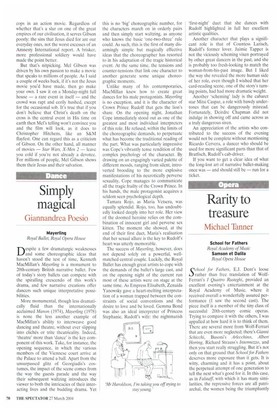Simply magical
Giannandrea Poesio
Mayerling Royal Ballet, Royal Opera House
Despite a few dramaturgic weaknesses and some choreographic ideas that haven't stood the test of time, Kenneth MacMillan's Mayerling is a monument to 20th-century British narrative ballet. Few of today's story ballets can compete with the spiralling crescendo of this work's drama, and few narrative creations offer dancers such unique interpretative possibilities.
More monumental, though less dramatically fluid than the internationally acclaimed Manon (1974), Mayerling (1978) is none the less another example of MacMillan's ability to interweave good dancing and theatre, without ever slipping into clichés or trite theatricality. Indeed, .theatre' more than 'dance' is the key component of this work. Take, for instance, the opening sequence, in which the various members of the Viennese court arrive at the Palace to attend a ball. Apart from the unsurpassed glitz of Georgiadis's costumes, the impact of the scene comes from the way the guests parade and the way their subsequent waltzing introduces the viewer to both the intricacies of their interacting lives and the budding drama. Yet this is no 'big' choreographic number, for the characters march on in orderly pairs and then simply start waltzing, as anyone who knows the basic 'one-two-three' rule could. As such, this is the first of many disarmingly simple but magically effective ideas that the choreographer has resorted to in his adaptation of the tragic historical event. At the same time, the tensions and counter-tensions that link one character to another generate some unique choreographic moments.
Unlike many of his contemporaries, MacMillan knew how to create great dances for his male protagonists. Mayerling is no exception, and it is the character of Crown Prince Rudolf that gets the lion's share. On the opening night, Jonathan Cope immediately stood out as one of the greatest and most individual interpreters of this role. He refused, within the limits of the choreographic demands, to perpetuate what has become the traditional reading of the part. What was particularly impressive was Cope's vibrantly tense rendition of the complex psychology of the character. By drawing on an engagingly varied palette of different moods, ranging from silent, introverted brooding to the more explosive manifestations of his neurotically perverse sexuality, Cope manages to communicate all the tragic frailty of the Crown Prince. In his hands, the male protagonist acquires a seldom seen psychological depth.
Tamara Rojo, as Maria Vetsera, was equally splendid. Rojo, too, has undoubtedly looked deeply into her role. Her view of the doomed heroine relies on the combination of innocent girl and perverse sex kitten. The moment she showed, at the end of their first duet, Maria's realisation that her sexual allure is the key to Rudolf s heart was utterly memorable.
The success of Mayerling, however, does not depend solely on a powerful, wellmatched central couple. Luckily, the Royal Ballet has enough great artists to cope with the demands of the ballet's large cast, and on the opening night of the current run most of these artists were on stage at the same time. As Empress Elisabeth, Zenaida Yanowsky gave a heart-melting interpretation of a woman trapped between the constraints of social conventions and the desire to love and be loved. Gemma Bond was also an ideal interpreter of Princess Stephanie, Rudolfs wife: the nightmarish 'first-night' duet that she dances with Rudolf highlighted in full her excellent artistic qualities.
Another character that plays a significant role is that of Countess Larisch, Rudolfs former lover. Jaimie Tapper is not the viciously scheming vixen portrayed by other great dancers in the past, and she is probably too fresh-looking to match the woman-from-his-past image. But I liked the way she revealed the more human side of her role, even though I wished that her card-reading scene, one of the story's turning points, had had more dramatic weight.
Another 'scheming' lady is the cabaret star Mitsi Caspar, a role with bawdy undertones that can be dangerously misread. Fortunately, Deirdre Chapman did not indulge in showing off and came across as a truly dangerous siren.
An appreciation of the artists who contributed to the success of the evening would not be complete without mentioning Ricardo Cervera, a dancer who should be used for more significant parts than that of Bratfisch, Rudolfs cab-driver.
If you want to get a clear idea of what the long-lost art of narrative ballet-making once was — and should still be — run for a ticket.


























































































 Previous page
Previous page